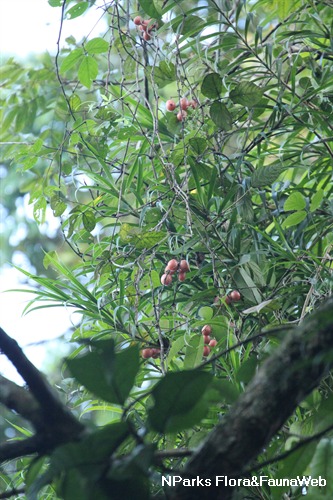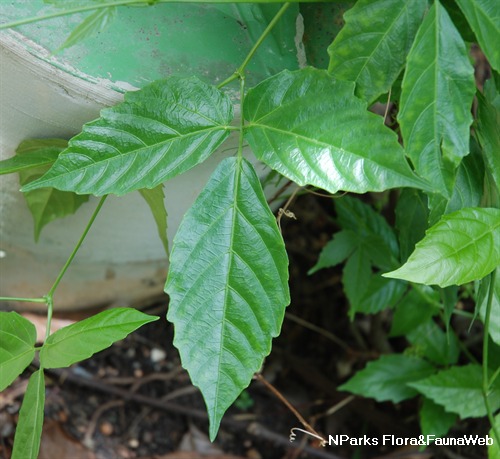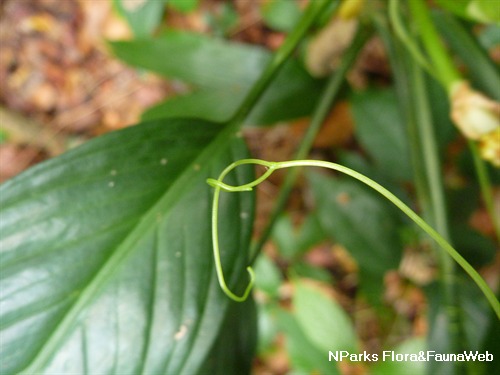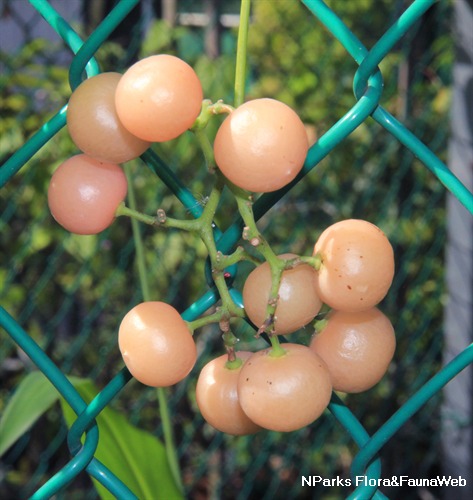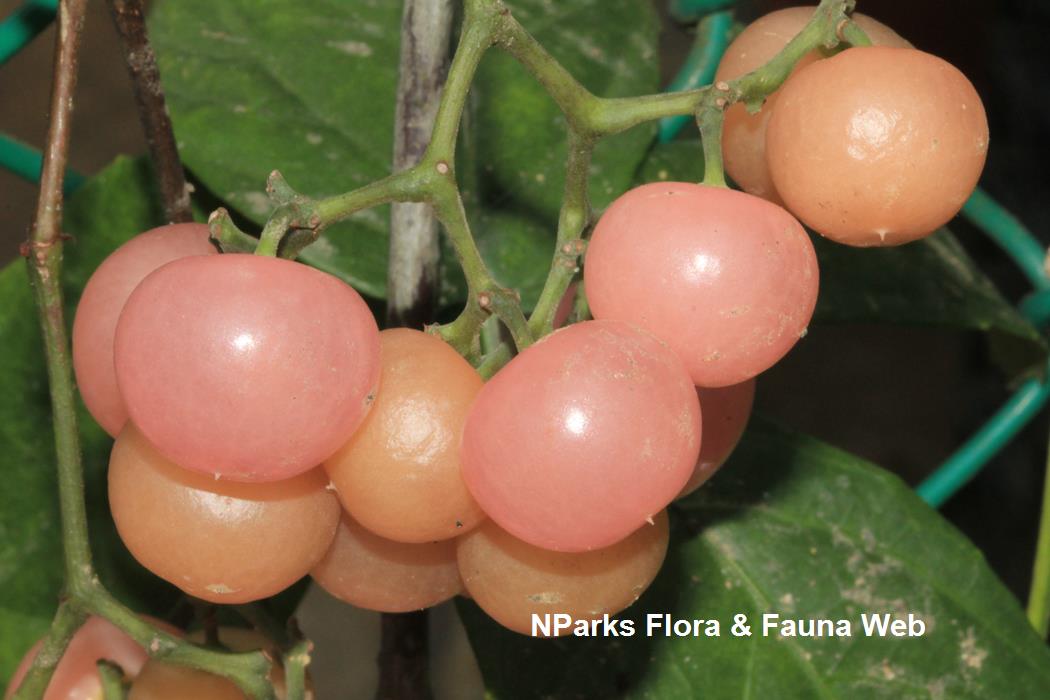
Back
Cayratia mollissima (Wall.) Gagnep.
| Family Name: | Vitaceae |
| Synonyms: | Cissus mollissima (Wall.) Planch., Vitis mollissima Wall. ex Roxb. |
| Common Name: | 乌蔹莓 |
Name
Classifications and Characteristics
| Plant Division | Angiosperms (Flowering Seed Plants) (Dicotyledon) |
|---|---|
| Plant Growth Form | Climber |
| Lifespan (in Singapore) | Perennial |
| Mode of Nutrition | Autotrophic |
| Plant Shape | Irregular |
Biogeography
| Native Distribution | India, Myanmar, Vietnam, Cambodia, Thailand, Peninsular Malaysia, and Singapore |
|---|---|
| Native Habitat | Terrestrial (Primary Rainforest, Secondary Rainforest, Freshwater Swamp Forest) |
| Preferred Climate Zone | Tropical, Sub-Tropical / Monsoonal |
| Local Conservation Status | Native to Singapore (Endangered (EN)) |
Description and Ethnobotany
| Growth Form | It is a herbaceous climber. |
|---|---|
| Foliage | Its spirally arranged, stalked leaves have 3 leaflets. The stalked leaflets have papery and toothed-margined leaf blades. The terminal leaflet blades are oval and 6.5–14 by 2.5–6.5 cm, while the lateral leaflet is asymmetric oblong and 4.5–12 by 1.5–6 cm. They are also sparsely covered with hair above, densely covered with hair below. |
| Stems | Stem is hairy and 1 cm in diameter. The tendril is green. |
| Flowers | Its stalked flowering shoots are found at the leaf axils. Its flowers are about 3 mm wide, with 4 bluish-green petals, a white disc, and a saucer-shaped structure formed by the outer, persistent flower parts (calyx). |
| Fruit | Its fruits are rounded berries, 22–30 by 20–27 mm, with 2–4 seeds each, maturing pink in colour. |
| Habitat | It grows on the fringe and understory of lowland dipterocarp and secondary forests. It occurs locally along Mandai Lake Road, in Nee Soon Swamp Forest, and in the vicinity of Upper Seletar Reservoir. |
| Associated Fauna | Its flowers are pollinated by bees, and butterflies, and its fruits and seeds may be eaten and dispersed by birds. The larvae of the plume moth (Deuterocopus melanota) have been observed to feed on the floral buds. |
| Cultivation | It can be propagated by from cuttings. The germination from seeds take 1–2 months. |
| Etymology | Latin Cayratia, from the Annamese vernacular name, cay-rat, a vine; Latin mollissimus, very soft, probably referring to the soft hairs on the stems and leaves. |
| Ethnobotanical Uses | Food (Herb or Spice): The leaves are known to be used to make tea. Medicinal: The plant is used in folk medicine to treat swelling and fever. |
Landscaping Features
| Landscaping | It is suitable for growing on pergolas and trellises in parks and gardens. |
|---|---|
| Desirable Plant Features | Ornamental Fruits, Ornamental Foliage |
| Landscape Uses | Parks & Gardens, Small Gardens, Trellis / Arbour / Pergola |
| Thematic Landscaping | Naturalistic Garden |
| Usage Hazard - Cons | Toxic Upon Ingestion, Irritant - Contact Allergy |
| Usage Hazard - Cons Remarks | The fruit contains calcium oxalate which irritates the skin and mucus membranes. |
Fauna, Pollination and Dispersal
| Fauna Pollination Dispersal Associated Fauna | Bird-Attracting, Butterfly-Attracting |
|---|---|
| Pollination Method(s) | Biotic (Fauna) |
| Seed or Spore Dispersal | Biotic (Fauna) |
Plant Care and Propagation
| Light Preference | Full Sun, Semi-Shade |
|---|---|
| Water Preference | Moderate Water |
| Plant Growth Rate | Moderate |
| Rootzone Tolerance | Fertile Loamy Soils, Well-Drained Soils, Moist Soils |
| Maintenance Requirements | Moderate |
| Propagation Method | Seed, Stem Cutting |
Foliar
| Foliage Retention | Evergreen |
|---|---|
| Mature Foliage Colour(s) | Green |
| Mature Foliage Texture(s) | Smooth, Hairy / Hirsute |
| Foliar Type | Compound (Trifoliate) |
| Foliar Arrangement Along Stem | Spiral |
| Foliar Attachment to Stem | Petiolate |
| Foliar Shape(s) | Non-Palm Foliage (Elliptical) |
| Foliar Venation | Pinnate / Net |
| Foliar Margin | Serrate / Toothed |
| Foliar Apex - Tip | Acuminate |
| Foliar Base | Rounded / Obtuse |
| Typical Foliar Area | Notophyll ( 20.25cm2 - 45 cm2 ) |
Non - Foliar and Storage
| Stem Type & Modification | Herbaceous |
|---|---|
| Root Type | Underground (Fibrous Root) |
Floral (Angiosperm)
| Flower & Plant Sexuality | Bisexual Flowers |
| Flower Colour(s) | Green - Light Green |
|---|---|
| Flower Grouping | Cluster / Inflorescence |
| Flower Location | Axillary |
| Flower Symmetry | Radial |
| Individual Flower Shape | Urceolate / Urn-shaped |
| Inflorescence Type | Cyme, Corymb |
| Flowering Habit | Polycarpic |
Fruit, Seed and Spore
| Mature Fruit Colour(s) | Pink |
|---|---|
| Fruit Classification | Simple Fruit |
| Fruit Type | Fleshy Fruit , Berry |
| Seed Description | Seeds are smooth and oblong in shape. |
Image Repository
Others
| Master ID | 68 |
|---|---|
| Species ID | 1364 |
| Flora Disclaimer | The information in this website has been compiled from reliable sources, such as reference works on medicinal plants. It is not a substitute for medical advice or treatment and NParks does not purport to provide any medical advice. Readers should always consult his/her physician before using or consuming a plant for medicinal purposes. |

